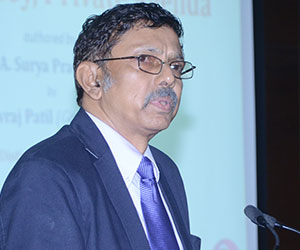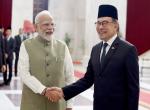With the situation in Andhra Pradesh virtually spiraling out of control and the union government, which triggered the chaos, becoming a mere spectator, the time has come for social and political leaders from across the political divide to display some statesmanship and initiate measures to cool tempers in both parts of the state and bring the warring groups back to the negotiating table.
While the Union Government and the Congress Party watch helplessly as the law and order situation in the Seemandhra region spirals out of control and party discipline has be thrown out of the window, Telugu Desam leader Mr.Chandrababu Naidu and the YSR Congress leader Mr.Jaganmohan Reddy are blaming Delhi and adding fuel to the fire. While it is true that the turmoil and uncertainty prevailing in the state can be traced to the myopic and desperate decisions taken by a ruling party merely for short-term political gain, one must guard against irretrievable constitutional breakdown and damage to the social fabric. The situation on the ground is so explosive that it calls for some initiative by a team of national elders. Partisan politics cannot douse these fires.
But, before we look for solutions, a look at the events that led to the current conflagration. Troubled by its waning influence in a large state like Andhra Pradesh that sends 42 MPs to the Lok Sabha, the Congress Working Committee (CWC) passed a resolution of July 30 last, urging the Union Government to take steps to divide Andhra Pradesh and create a separate Telangana state. The CWC resolution triggered conflicting emotions in the Telangana and Andhra regions. There was jubilation in the areas which would constitute the new state and violent agitations in the other regions of the state. Thereafter, there have been tensions in all the three regions of the state – Telangana, Rayalaseema and Coastal Andhra – because of the absence of clarity on many fundamental issues pertaining to the creation of the new state. For example, there is much confusion on the status of Hyderabad. Telangana does not want Hyderabad to be a Union Territory which will be home to the capitals of both Telangana and Seemandhra. The people of Seemandhra do not want Hyderabad to be wholly a part of Telangana. Meanwhile, the people of Rayalaseema feel they have been short-changed.
Two months have gone by and the ruling dispensation in Delhi appears all at sea on how to implement the Congress Party’s resolution. A high-powered committee headed by Defence Minister Mr.A.K.Anthony was set up to examine all these issues and untangle the mess. Meanwhile, without waiting for Anthony et al to complete their deliberations, the government decided to go ahead with the division of the state and set up a Group of Ministers to work out the modalities. The GoM is to work out the nitty-gritty of bifurcation of the state including assets, revenues and liabilities. Meanwhile, both the Union Government and the Congress leadership has to contend with the virtual revolt of the Andhra Pradesh Chief Minister Mr Kiran Kumar Reddy, who has blasted the party high command for taking such a sensitive decision without proper consultations and deliberation on the consequences of bifurcation of the state.
The Chief Minister is so angry with his party that he said a few days ago that he never thought a day would come when “I have to choose between my party-Congress- and my state. I would not wish such a quandary to even my worst enemy. But if I, as CM of this state, allow this to happen, future generations of Telugu people won’t forgive me”.
He said he stood for a united Andhra Pradesh even when he was an MLA and there was no change in his stance. Challenging the party’s decision, he said “the CWC has taken this decision but as the Chief Minister, I have a responsibility to this state and its people not to allow this mistake to be carried forward”. He said the party had decided to form Telangana without any discussion on important issues like water-sharing, irrigation, status of government employees etc.
The Chief Minister’s rebellious attitude became clear when he publicly declared that he felt like joining the agitationists who wanted Andhra to remain united. Given the amount of turmoil in all the three regions of the state, one wonders what lies ahead on the Telangana question.
The CWC’s decision to bifurcate Andhra Pradesh and create the state of Telangana has triggered a rash of demands for new states – a development that does not augur well from a national unity point of view. Already, a dozen new demands have sprung up. The Bodos and the Gorkhas have resumed their agitations for creation of Bodoland and Gorkhaland; Ms.Mayawati has reiterated her demand for breaking up Uttar Pradesh into four states – Purvanchal, Bundelkhand, Awadh Pradesh and Paschim Pradesh; Mr.Ajit Singh has once again raised the flag of Harit Pradesh; politicians of Vidharbha have suddenly re-discovered the virtues of a separate Vidarbha State; the Coorgis are clamouring for a separate state and finally, there are political parties in Tamil Nadu who want to break up the Tamil state.
After keeping the Telangana issue on the backburner for close to 60 years, the decision of the CWC smacks of desperation and recklessness, because the timing is all wrong for the following reasons: While the creation of smaller states made sense 30 years ago, the political situation in India has changed rather dramatically in recent times leading to the splintering of the polity and the emergence of dozens of small, regional parties and unstable coalitions at the Centre. The most dangerous consequence of these developments is that they have enfeebled the Centre and made it extremely weak and vulnerable. The best example of the Centre’s loss of strength is its failure to push through the idea of an unified National Counter-Terrorism Centre. A nation like India which is the most diverse society on earth in terms of race, culture, religion, caste and language and which has 28 states and many Union Territories, needs a strong Centre to hold it together. This was the case in the first thirty years of our Republic, but as the Congress Party became more and more arrogant and opportunistic, regional politicians encashed on the Congress’ follies, stirred up regional sentiments and promoted smaller, denominational political entities in different parts of the country. The result is there for all of us to see now.
In 1957, the Second Lok Sabha had MPs representing 12 political parties. Fifty years hence, the Lok Sabha had 42 political parties. The way things are going, we should be ready for 60 or more political parties. If the experience of the past 17 years is anything to go by, the smaller, regional parties in the coalitions that have ruled the country since 1996 have substantially hindered governance because of their incapacity to look beyond their spheres of influence. Many of them have virtually blackmailed successive prime ministers and got away with gross inefficiency and corruption. All this has substantially weakened the Union Government and the office of the Prime Minister. Newer political formations and further splintering of the polity will certainly be a recipe for disaster.
In the 1950s, the reorganisation of states was primarily on the basis of language. The process was triggered by Potti Sriramulu, who undertook a fast unto death to press for creation of a Telugu State. This was granted soon after his death because of the large scale violence it triggered across Andhra. Thereafter, the Nehru government appointed the States Reorganisation Commission headed by Justice Fazal Ali.
In its report, submitted in 1955, this Commission considered the demand for Telangana and weighed it against the advantages of one unified Telugu-speaking state and made the following observations:
The advantages of a larger Andhra State including Telangana are that it will bring into existence a state of about 32 millions with a considerable hinterland, with large water and power resources, adequate mineral wealth and valuable raw materials. This will also solve the difficult and vexing problem of finding a permanent capital for Andhra, the twin cities of Hyderabad and Secunderabad are very well suited to be the capital of Vishalandhra. The considerations which have been argued in favour of a separate Telangana State are, however, not such as may be lightly brushed aside.
One of the principal causes of opposition of Vishalandhra was the apprehension felt by the educationally backward people of Telangana that they may be swamped and exploited by the more advanced people of the coastal areas because in the Telangana districts outside the city of Hyderabad, education is woefully backward. After taking all these factors into consideration, the commission came to the conclusion that it will be in the interests of Andhra as well as Telangana if Telangana were to constitute a separate State, which may be known as the Hyderabad State “with provision for its unification with Andhra after the general elections likely to be held in or about 1961 if by a two thirds majority the legislature of the residency Hyderabad State expresses itself in favor of such unification”.
The Commission said the advantage of this arrangement will be that while the objective of the unification of the Andhras will neither be blurred nor impeded during a period of five or six years, the two governments may have stabilized their administrative machinery and, if possible, also reviewed their land revenue systems etc., the object in view being the attainment of uniformity. The intervening period may incidentally provide an opportunity for allaying apprehensions and achieving the consensus of opinion necessary for a real union between the two States. Andhra and Telangana have common interests and we hope these interests will tend to bring the people closer to each other. “If, however, our hopes for the development of the environment and conditions congenial to the unification of the two areas do not materialise and if public sentiment in Telangana crystallises itself against the unification of the two states, Telangana will have to continue as a separate unit”.
In other words, in 1955, the States Reorganisation Commission was clearly in favour of a separate Telangana State to begin with. If the two parts of Andhra Pradesh agreed, then unification could take place after 1961. The Nehru government rejected this recommendation and went ahead with the formation of a unified Telugu State called Andhra Pradesh. Thereafter even Prime Minister Indira Gandhi decided not to tinker with the geography of Andhra Pradesh, although the Telangana agitation kept simmering throughout the 1970s and 80s. Chief Minister Kiran Kumar Reddy questioned the wisdom of the present leaders of the Congress Party when he said “when Pandit Jawaharlal Nehru and Indira Gandhi, after careful consideration, felt that the state should remain united”, the attitude of the present leadership did not make sense.
Many decades later, in February, 2010, the Congress headed by Ms.Sonia Gandhi prompted the Manmohan Singh Government to constitute yet another committee to consider the Telangana issue. Even this committee headed by Justice B.N.Srikrishna did not favour the bifurcation of Andhra Pradesh. It said :
In view of various considerations indicated earlier, the Committee is convinced that the development aspect was of utmost importance for the welfare of all the three regions and could best be addressed through a model that includes deeper and more extensive economic and political decentralisation. The Committee believes that overall it may not be necessary to have a duplication or multiplication of capitals, assemblies, ministries, courts, institutions and administrative infrastructure required by the other options. The Committee considers that unity is in the best interest of all the three regions of the state as internal partitions would not be conducive to providing sustainable solutions to the issues at hand. In this option, it is proposed to keep the state united and provide constitutional/statutory measures to address the core socio-economic concerns about development of Telangana region. This can be done through the establishment of a statutory and empowered Telangana Regional Council with adequate transfer of funds, functions and functionaries in keeping with the spirit of Gentlemen’s Agreement of 1956. The Regional Council would provide a legislative consultative mechanism for the subjects to be dealt with by the Council.
The Srikrishna Committee suggested the following subjects for the proposed Telangana Regional Council: Planning & Economic Development, including preparation of development sub-plan for the region as part of State Plan, Water and Irrigation sector, Education (primary and secondary); Skill development and vocational education, Local Administration. Public Health (up to district hospitals excluding medical colleges and speciality health care).
The Committee said it was suggesting the united Andhra option for continuing the development momentum of the three regions and keeping in mind the national perspective. “With firm political and administrative management it should be possible to convey conviction to the people that this option would be in the best interest of all and would provide satisfaction to the maximum number of people in the state. It would also take care of the uncertainty over the future of Hyderabad as a bustling educational, industrial and IT hub/destination”.
The Srikrishna Committee was most worried about the consequences of granting statehood to Telangana. Taking note of the demand for Gorkhaland, Bodoland, Bundelkhand etc, it said, “the division of the state will also have serious implications outside Andhra Pradesh. It would not only give fillip to other similar demands but it will be for the first time, after the re-organisation of states, that a political demand for dividing a linguistically constituted state would have been conceded by the Union Government with the creation of two Telugu speaking states. The issue requires a most calm and dispassionate consideration of the consequences”.
As can be seen, Nehru rejected the Justice Fazal Ali Commission Report in 1955 and Sonia Gandhi rejected the Justice Srikrishna Committee Report in 2013. On both occasions, the Congress Party has done what suited it best. The country as a whole will now have to bear the consequences. If India is to overcome this crisis and survive the Congress Party’s myopic political decisions, there is need for statesmanship both at the national and state level. Ideally a group of eminent Indians from different walks of life must step in to bring back peace to the two warring regions of Andhra Pradesh and untangle the mess created by politicians. Will some on take the call?
Published Date: 12th October 2013, Image source: http://media.newindianexpress.com










Post new comment